Critical Review: Human Factors Relationship with Quality and Safety
VerifiedAdded on 2023/06/04
|10
|2939
|86
Report
AI Summary
This report provides a critical analysis of human factors impacting work performance and their relationship to quality and safety in healthcare provision. It explores concepts such as work environment, team leadership, individual factors, and workgroup dynamics, highlighting key issues like communication, decision-making, and stress. The report establishes the relationship between these factors and healthcare quality and safety, emphasizing the importance of a positive work environment, effective leadership, and individual well-being. The analysis concludes that human factors significantly influence healthcare outcomes, necessitating a focus on improving employee performance and patient care. Desklib provides access to this and similar solved assignments for students' reference.
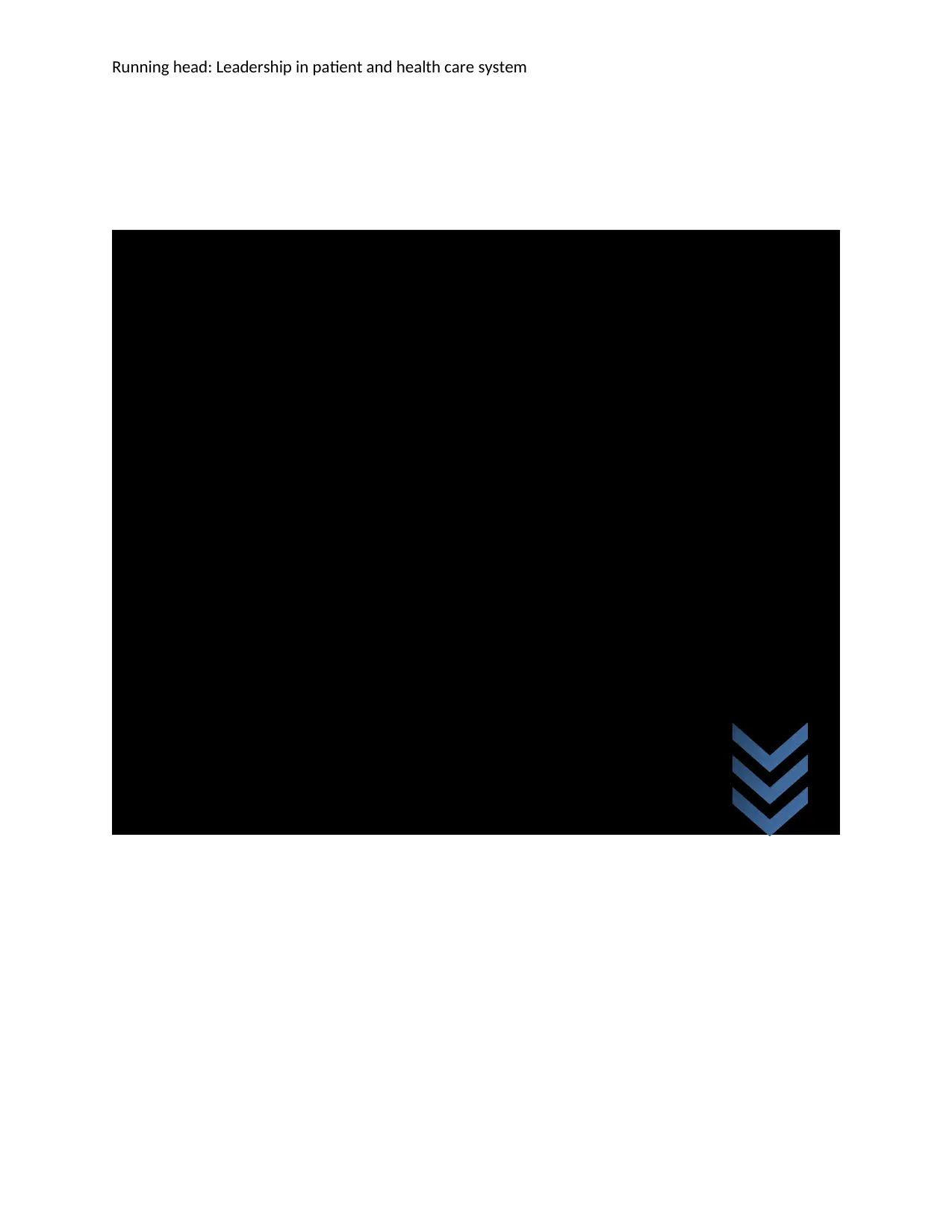
Running head: Leadership in patient and health care system
Paraphrase This Document
Need a fresh take? Get an instant paraphrase of this document with our AI Paraphraser
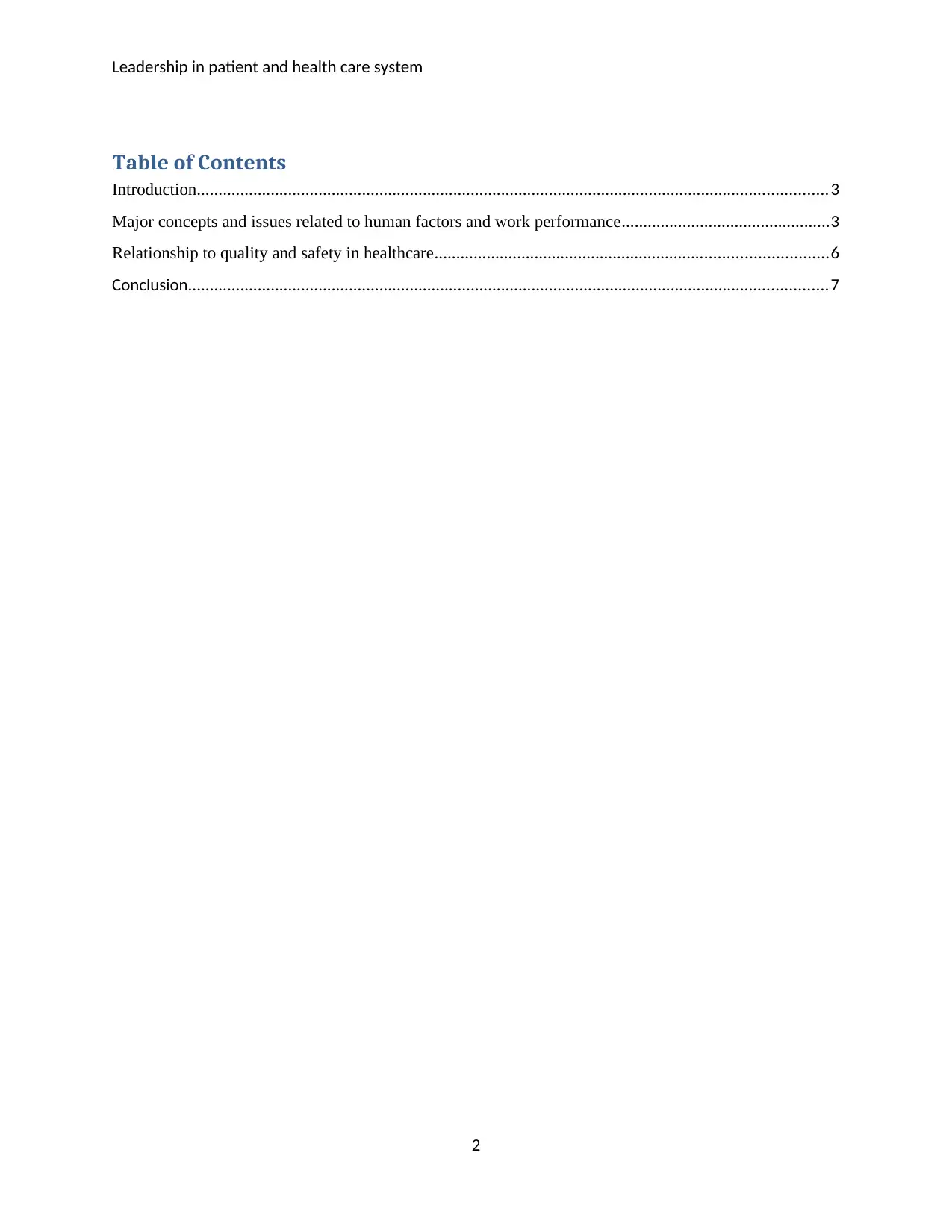
Leadership in patient and health care system
Table of Contents
Introduction.................................................................................................................................................3
Major concepts and issues related to human factors and work performance................................................3
Relationship to quality and safety in healthcare..........................................................................................6
Conclusion...................................................................................................................................................7
2
Table of Contents
Introduction.................................................................................................................................................3
Major concepts and issues related to human factors and work performance................................................3
Relationship to quality and safety in healthcare..........................................................................................6
Conclusion...................................................................................................................................................7
2
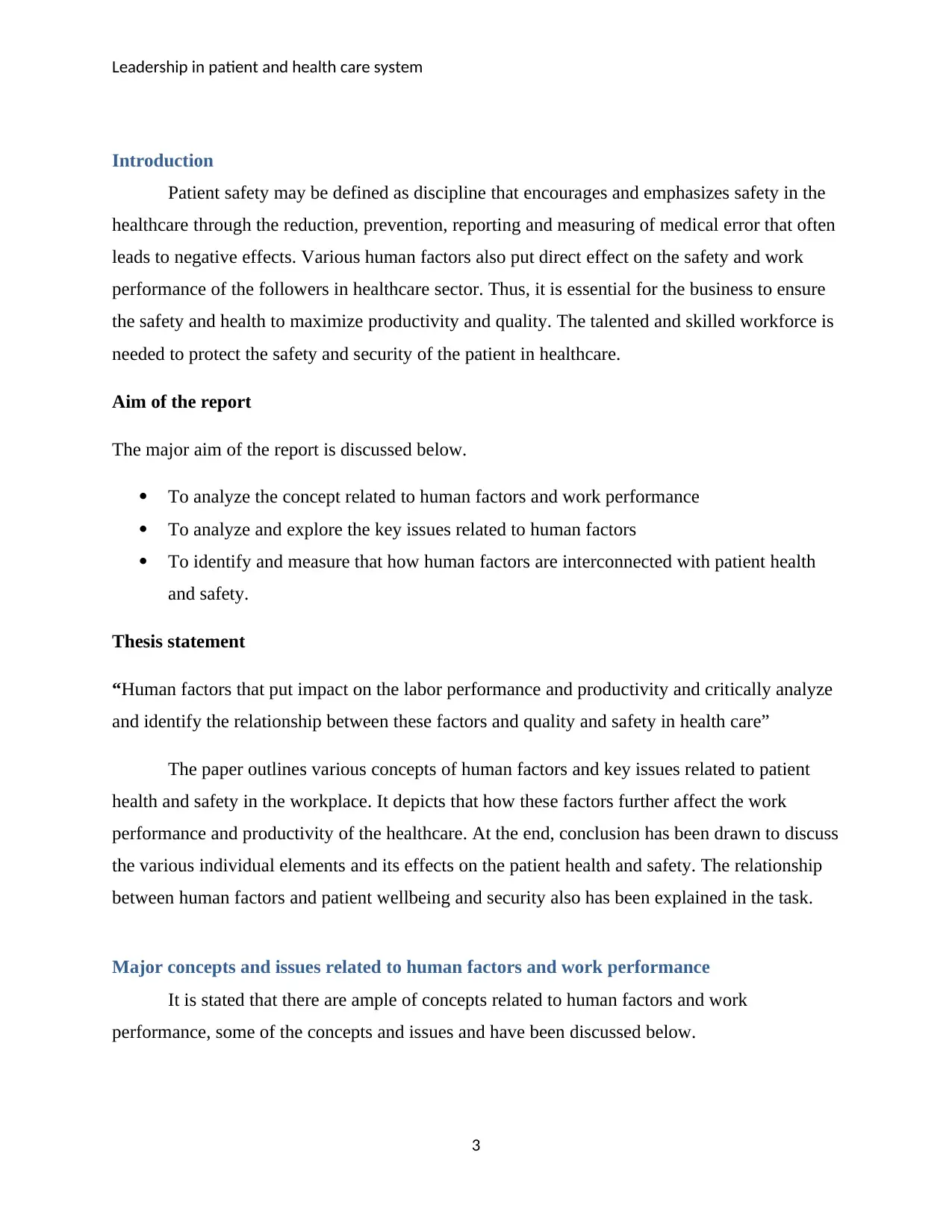
Leadership in patient and health care system
Introduction
Patient safety may be defined as discipline that encourages and emphasizes safety in the
healthcare through the reduction, prevention, reporting and measuring of medical error that often
leads to negative effects. Various human factors also put direct effect on the safety and work
performance of the followers in healthcare sector. Thus, it is essential for the business to ensure
the safety and health to maximize productivity and quality. The talented and skilled workforce is
needed to protect the safety and security of the patient in healthcare.
Aim of the report
The major aim of the report is discussed below.
To analyze the concept related to human factors and work performance
To analyze and explore the key issues related to human factors
To identify and measure that how human factors are interconnected with patient health
and safety.
Thesis statement
“Human factors that put impact on the labor performance and productivity and critically analyze
and identify the relationship between these factors and quality and safety in health care”
The paper outlines various concepts of human factors and key issues related to patient
health and safety in the workplace. It depicts that how these factors further affect the work
performance and productivity of the healthcare. At the end, conclusion has been drawn to discuss
the various individual elements and its effects on the patient health and safety. The relationship
between human factors and patient wellbeing and security also has been explained in the task.
Major concepts and issues related to human factors and work performance
It is stated that there are ample of concepts related to human factors and work
performance, some of the concepts and issues and have been discussed below.
3
Introduction
Patient safety may be defined as discipline that encourages and emphasizes safety in the
healthcare through the reduction, prevention, reporting and measuring of medical error that often
leads to negative effects. Various human factors also put direct effect on the safety and work
performance of the followers in healthcare sector. Thus, it is essential for the business to ensure
the safety and health to maximize productivity and quality. The talented and skilled workforce is
needed to protect the safety and security of the patient in healthcare.
Aim of the report
The major aim of the report is discussed below.
To analyze the concept related to human factors and work performance
To analyze and explore the key issues related to human factors
To identify and measure that how human factors are interconnected with patient health
and safety.
Thesis statement
“Human factors that put impact on the labor performance and productivity and critically analyze
and identify the relationship between these factors and quality and safety in health care”
The paper outlines various concepts of human factors and key issues related to patient
health and safety in the workplace. It depicts that how these factors further affect the work
performance and productivity of the healthcare. At the end, conclusion has been drawn to discuss
the various individual elements and its effects on the patient health and safety. The relationship
between human factors and patient wellbeing and security also has been explained in the task.
Major concepts and issues related to human factors and work performance
It is stated that there are ample of concepts related to human factors and work
performance, some of the concepts and issues and have been discussed below.
3
⊘ This is a preview!⊘
Do you want full access?
Subscribe today to unlock all pages.

Trusted by 1+ million students worldwide
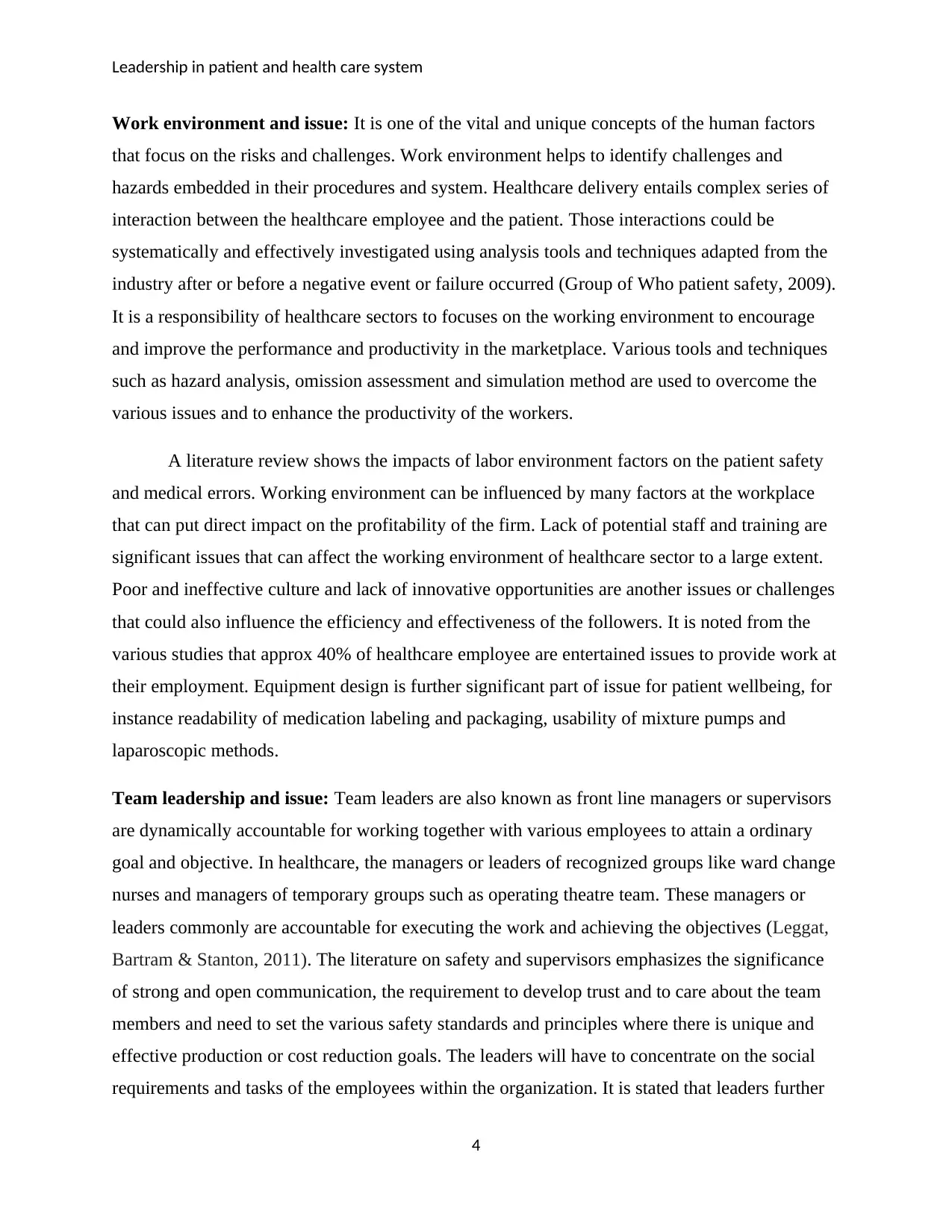
Leadership in patient and health care system
Work environment and issue: It is one of the vital and unique concepts of the human factors
that focus on the risks and challenges. Work environment helps to identify challenges and
hazards embedded in their procedures and system. Healthcare delivery entails complex series of
interaction between the healthcare employee and the patient. Those interactions could be
systematically and effectively investigated using analysis tools and techniques adapted from the
industry after or before a negative event or failure occurred (Group of Who patient safety, 2009).
It is a responsibility of healthcare sectors to focuses on the working environment to encourage
and improve the performance and productivity in the marketplace. Various tools and techniques
such as hazard analysis, omission assessment and simulation method are used to overcome the
various issues and to enhance the productivity of the workers.
A literature review shows the impacts of labor environment factors on the patient safety
and medical errors. Working environment can be influenced by many factors at the workplace
that can put direct impact on the profitability of the firm. Lack of potential staff and training are
significant issues that can affect the working environment of healthcare sector to a large extent.
Poor and ineffective culture and lack of innovative opportunities are another issues or challenges
that could also influence the efficiency and effectiveness of the followers. It is noted from the
various studies that approx 40% of healthcare employee are entertained issues to provide work at
their employment. Equipment design is further significant part of issue for patient wellbeing, for
instance readability of medication labeling and packaging, usability of mixture pumps and
laparoscopic methods.
Team leadership and issue: Team leaders are also known as front line managers or supervisors
are dynamically accountable for working together with various employees to attain a ordinary
goal and objective. In healthcare, the managers or leaders of recognized groups like ward change
nurses and managers of temporary groups such as operating theatre team. These managers or
leaders commonly are accountable for executing the work and achieving the objectives (Leggat,
Bartram & Stanton, 2011). The literature on safety and supervisors emphasizes the significance
of strong and open communication, the requirement to develop trust and to care about the team
members and need to set the various safety standards and principles where there is unique and
effective production or cost reduction goals. The leaders will have to concentrate on the social
requirements and tasks of the employees within the organization. It is stated that leaders further
4
Work environment and issue: It is one of the vital and unique concepts of the human factors
that focus on the risks and challenges. Work environment helps to identify challenges and
hazards embedded in their procedures and system. Healthcare delivery entails complex series of
interaction between the healthcare employee and the patient. Those interactions could be
systematically and effectively investigated using analysis tools and techniques adapted from the
industry after or before a negative event or failure occurred (Group of Who patient safety, 2009).
It is a responsibility of healthcare sectors to focuses on the working environment to encourage
and improve the performance and productivity in the marketplace. Various tools and techniques
such as hazard analysis, omission assessment and simulation method are used to overcome the
various issues and to enhance the productivity of the workers.
A literature review shows the impacts of labor environment factors on the patient safety
and medical errors. Working environment can be influenced by many factors at the workplace
that can put direct impact on the profitability of the firm. Lack of potential staff and training are
significant issues that can affect the working environment of healthcare sector to a large extent.
Poor and ineffective culture and lack of innovative opportunities are another issues or challenges
that could also influence the efficiency and effectiveness of the followers. It is noted from the
various studies that approx 40% of healthcare employee are entertained issues to provide work at
their employment. Equipment design is further significant part of issue for patient wellbeing, for
instance readability of medication labeling and packaging, usability of mixture pumps and
laparoscopic methods.
Team leadership and issue: Team leaders are also known as front line managers or supervisors
are dynamically accountable for working together with various employees to attain a ordinary
goal and objective. In healthcare, the managers or leaders of recognized groups like ward change
nurses and managers of temporary groups such as operating theatre team. These managers or
leaders commonly are accountable for executing the work and achieving the objectives (Leggat,
Bartram & Stanton, 2011). The literature on safety and supervisors emphasizes the significance
of strong and open communication, the requirement to develop trust and to care about the team
members and need to set the various safety standards and principles where there is unique and
effective production or cost reduction goals. The leaders will have to concentrate on the social
requirements and tasks of the employees within the organization. It is stated that leaders further
4
Paraphrase This Document
Need a fresh take? Get an instant paraphrase of this document with our AI Paraphraser
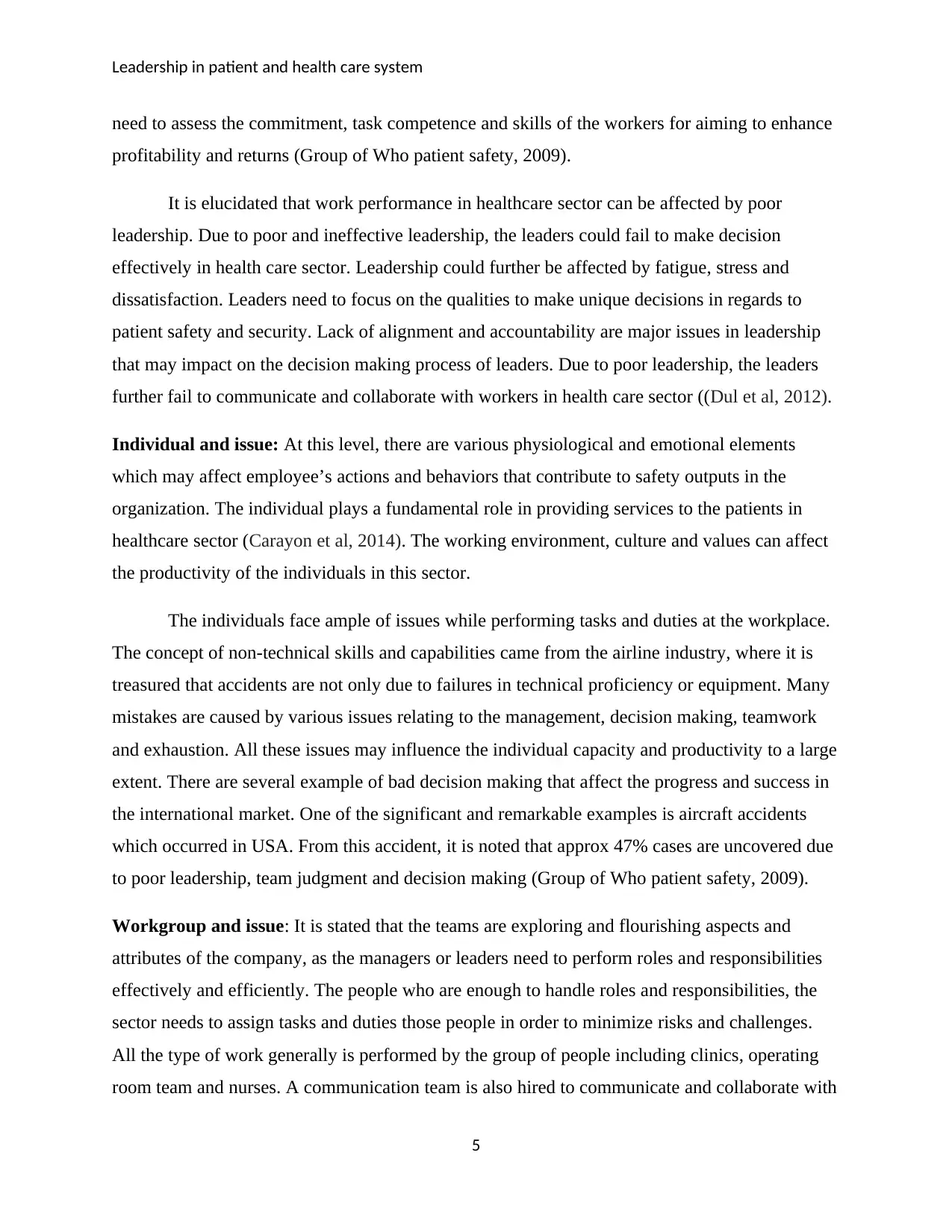
Leadership in patient and health care system
need to assess the commitment, task competence and skills of the workers for aiming to enhance
profitability and returns (Group of Who patient safety, 2009).
It is elucidated that work performance in healthcare sector can be affected by poor
leadership. Due to poor and ineffective leadership, the leaders could fail to make decision
effectively in health care sector. Leadership could further be affected by fatigue, stress and
dissatisfaction. Leaders need to focus on the qualities to make unique decisions in regards to
patient safety and security. Lack of alignment and accountability are major issues in leadership
that may impact on the decision making process of leaders. Due to poor leadership, the leaders
further fail to communicate and collaborate with workers in health care sector ((Dul et al, 2012).
Individual and issue: At this level, there are various physiological and emotional elements
which may affect employee’s actions and behaviors that contribute to safety outputs in the
organization. The individual plays a fundamental role in providing services to the patients in
healthcare sector (Carayon et al, 2014). The working environment, culture and values can affect
the productivity of the individuals in this sector.
The individuals face ample of issues while performing tasks and duties at the workplace.
The concept of non-technical skills and capabilities came from the airline industry, where it is
treasured that accidents are not only due to failures in technical proficiency or equipment. Many
mistakes are caused by various issues relating to the management, decision making, teamwork
and exhaustion. All these issues may influence the individual capacity and productivity to a large
extent. There are several example of bad decision making that affect the progress and success in
the international market. One of the significant and remarkable examples is aircraft accidents
which occurred in USA. From this accident, it is noted that approx 47% cases are uncovered due
to poor leadership, team judgment and decision making (Group of Who patient safety, 2009).
Workgroup and issue: It is stated that the teams are exploring and flourishing aspects and
attributes of the company, as the managers or leaders need to perform roles and responsibilities
effectively and efficiently. The people who are enough to handle roles and responsibilities, the
sector needs to assign tasks and duties those people in order to minimize risks and challenges.
All the type of work generally is performed by the group of people including clinics, operating
room team and nurses. A communication team is also hired to communicate and collaborate with
5
need to assess the commitment, task competence and skills of the workers for aiming to enhance
profitability and returns (Group of Who patient safety, 2009).
It is elucidated that work performance in healthcare sector can be affected by poor
leadership. Due to poor and ineffective leadership, the leaders could fail to make decision
effectively in health care sector. Leadership could further be affected by fatigue, stress and
dissatisfaction. Leaders need to focus on the qualities to make unique decisions in regards to
patient safety and security. Lack of alignment and accountability are major issues in leadership
that may impact on the decision making process of leaders. Due to poor leadership, the leaders
further fail to communicate and collaborate with workers in health care sector ((Dul et al, 2012).
Individual and issue: At this level, there are various physiological and emotional elements
which may affect employee’s actions and behaviors that contribute to safety outputs in the
organization. The individual plays a fundamental role in providing services to the patients in
healthcare sector (Carayon et al, 2014). The working environment, culture and values can affect
the productivity of the individuals in this sector.
The individuals face ample of issues while performing tasks and duties at the workplace.
The concept of non-technical skills and capabilities came from the airline industry, where it is
treasured that accidents are not only due to failures in technical proficiency or equipment. Many
mistakes are caused by various issues relating to the management, decision making, teamwork
and exhaustion. All these issues may influence the individual capacity and productivity to a large
extent. There are several example of bad decision making that affect the progress and success in
the international market. One of the significant and remarkable examples is aircraft accidents
which occurred in USA. From this accident, it is noted that approx 47% cases are uncovered due
to poor leadership, team judgment and decision making (Group of Who patient safety, 2009).
Workgroup and issue: It is stated that the teams are exploring and flourishing aspects and
attributes of the company, as the managers or leaders need to perform roles and responsibilities
effectively and efficiently. The people who are enough to handle roles and responsibilities, the
sector needs to assign tasks and duties those people in order to minimize risks and challenges.
All the type of work generally is performed by the group of people including clinics, operating
room team and nurses. A communication team is also hired to communicate and collaborate with
5
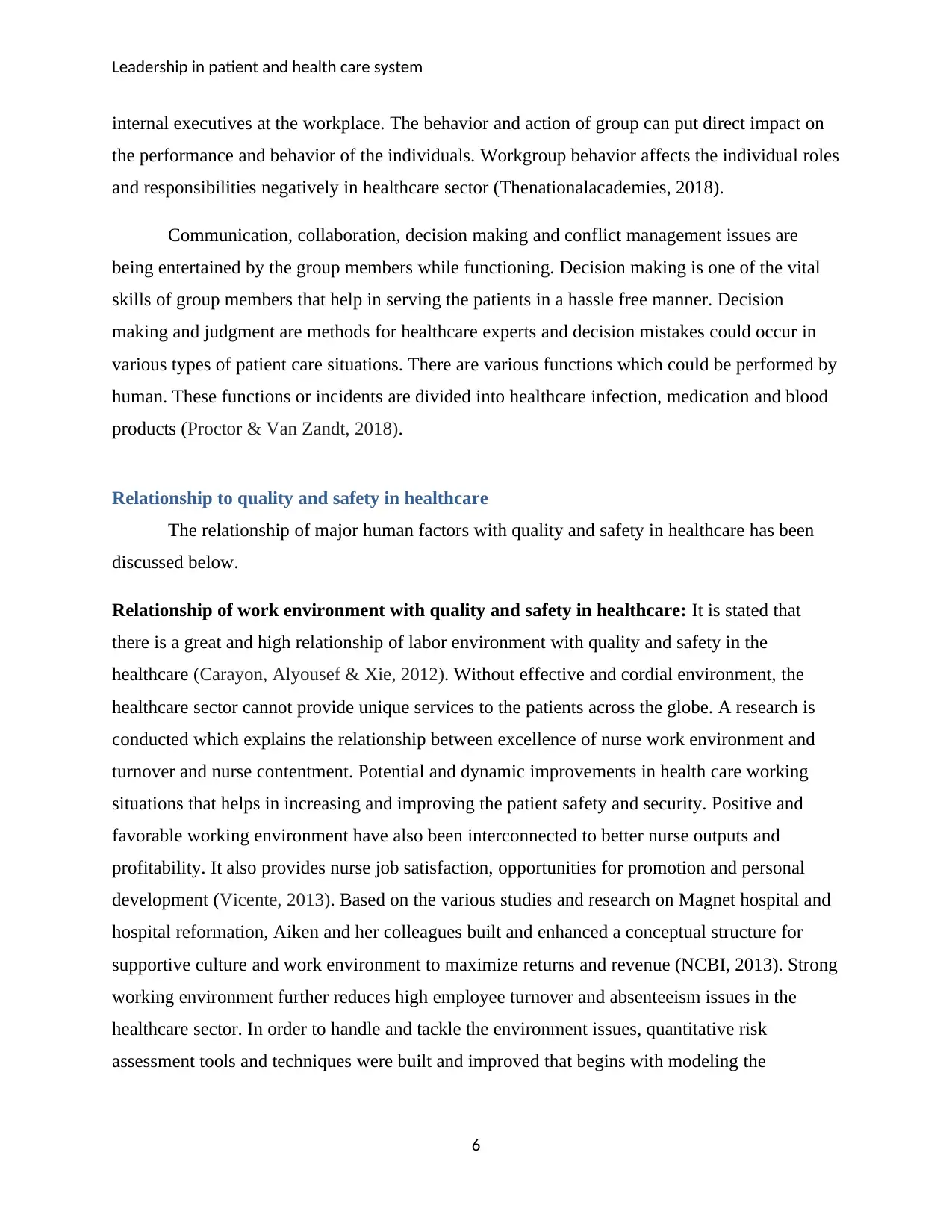
Leadership in patient and health care system
internal executives at the workplace. The behavior and action of group can put direct impact on
the performance and behavior of the individuals. Workgroup behavior affects the individual roles
and responsibilities negatively in healthcare sector (Thenationalacademies, 2018).
Communication, collaboration, decision making and conflict management issues are
being entertained by the group members while functioning. Decision making is one of the vital
skills of group members that help in serving the patients in a hassle free manner. Decision
making and judgment are methods for healthcare experts and decision mistakes could occur in
various types of patient care situations. There are various functions which could be performed by
human. These functions or incidents are divided into healthcare infection, medication and blood
products (Proctor & Van Zandt, 2018).
Relationship to quality and safety in healthcare
The relationship of major human factors with quality and safety in healthcare has been
discussed below.
Relationship of work environment with quality and safety in healthcare: It is stated that
there is a great and high relationship of labor environment with quality and safety in the
healthcare (Carayon, Alyousef & Xie, 2012). Without effective and cordial environment, the
healthcare sector cannot provide unique services to the patients across the globe. A research is
conducted which explains the relationship between excellence of nurse work environment and
turnover and nurse contentment. Potential and dynamic improvements in health care working
situations that helps in increasing and improving the patient safety and security. Positive and
favorable working environment have also been interconnected to better nurse outputs and
profitability. It also provides nurse job satisfaction, opportunities for promotion and personal
development (Vicente, 2013). Based on the various studies and research on Magnet hospital and
hospital reformation, Aiken and her colleagues built and enhanced a conceptual structure for
supportive culture and work environment to maximize returns and revenue (NCBI, 2013). Strong
working environment further reduces high employee turnover and absenteeism issues in the
healthcare sector. In order to handle and tackle the environment issues, quantitative risk
assessment tools and techniques were built and improved that begins with modeling the
6
internal executives at the workplace. The behavior and action of group can put direct impact on
the performance and behavior of the individuals. Workgroup behavior affects the individual roles
and responsibilities negatively in healthcare sector (Thenationalacademies, 2018).
Communication, collaboration, decision making and conflict management issues are
being entertained by the group members while functioning. Decision making is one of the vital
skills of group members that help in serving the patients in a hassle free manner. Decision
making and judgment are methods for healthcare experts and decision mistakes could occur in
various types of patient care situations. There are various functions which could be performed by
human. These functions or incidents are divided into healthcare infection, medication and blood
products (Proctor & Van Zandt, 2018).
Relationship to quality and safety in healthcare
The relationship of major human factors with quality and safety in healthcare has been
discussed below.
Relationship of work environment with quality and safety in healthcare: It is stated that
there is a great and high relationship of labor environment with quality and safety in the
healthcare (Carayon, Alyousef & Xie, 2012). Without effective and cordial environment, the
healthcare sector cannot provide unique services to the patients across the globe. A research is
conducted which explains the relationship between excellence of nurse work environment and
turnover and nurse contentment. Potential and dynamic improvements in health care working
situations that helps in increasing and improving the patient safety and security. Positive and
favorable working environment have also been interconnected to better nurse outputs and
profitability. It also provides nurse job satisfaction, opportunities for promotion and personal
development (Vicente, 2013). Based on the various studies and research on Magnet hospital and
hospital reformation, Aiken and her colleagues built and enhanced a conceptual structure for
supportive culture and work environment to maximize returns and revenue (NCBI, 2013). Strong
working environment further reduces high employee turnover and absenteeism issues in the
healthcare sector. In order to handle and tackle the environment issues, quantitative risk
assessment tools and techniques were built and improved that begins with modeling the
6
⊘ This is a preview!⊘
Do you want full access?
Subscribe today to unlock all pages.

Trusted by 1+ million students worldwide
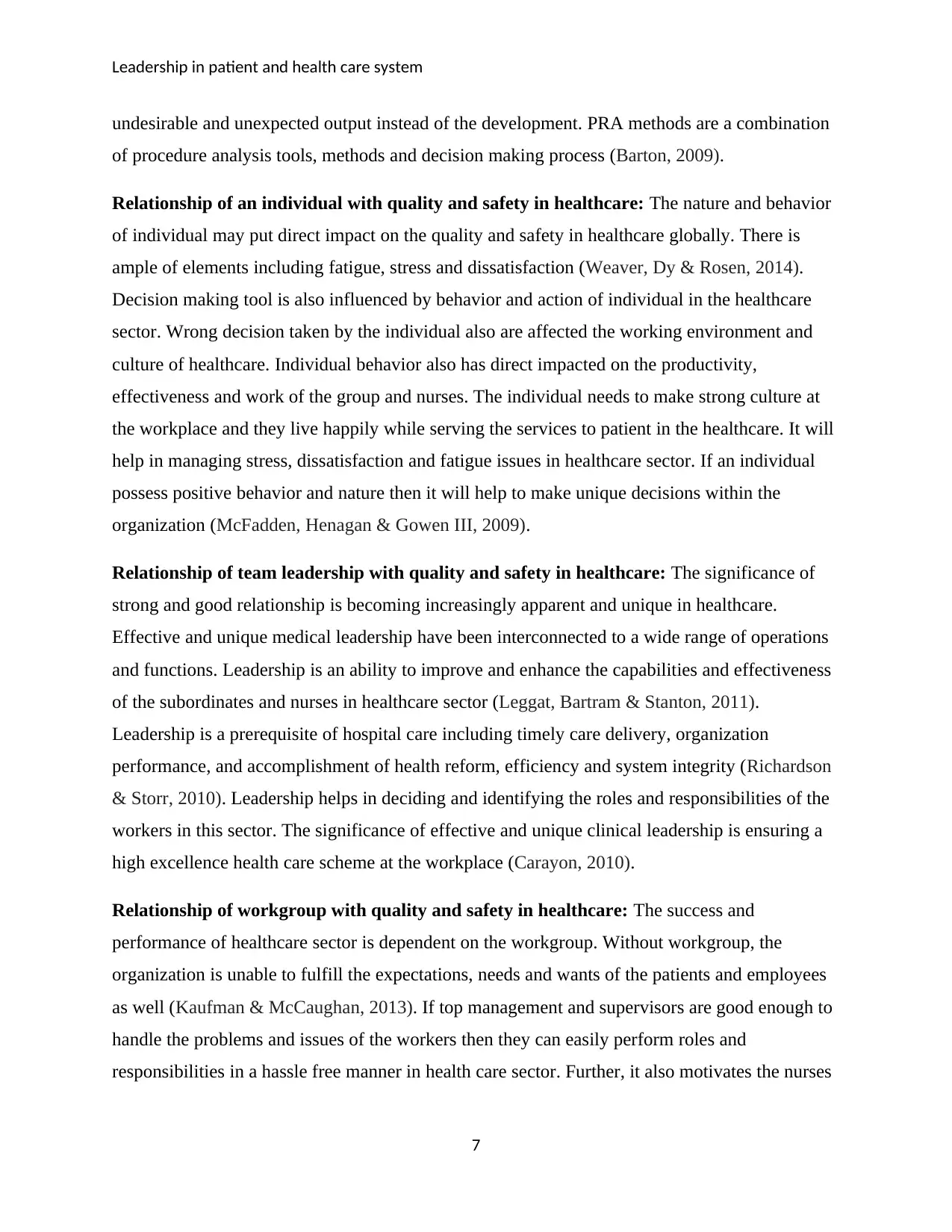
Leadership in patient and health care system
undesirable and unexpected output instead of the development. PRA methods are a combination
of procedure analysis tools, methods and decision making process (Barton, 2009).
Relationship of an individual with quality and safety in healthcare: The nature and behavior
of individual may put direct impact on the quality and safety in healthcare globally. There is
ample of elements including fatigue, stress and dissatisfaction (Weaver, Dy & Rosen, 2014).
Decision making tool is also influenced by behavior and action of individual in the healthcare
sector. Wrong decision taken by the individual also are affected the working environment and
culture of healthcare. Individual behavior also has direct impacted on the productivity,
effectiveness and work of the group and nurses. The individual needs to make strong culture at
the workplace and they live happily while serving the services to patient in the healthcare. It will
help in managing stress, dissatisfaction and fatigue issues in healthcare sector. If an individual
possess positive behavior and nature then it will help to make unique decisions within the
organization (McFadden, Henagan & Gowen III, 2009).
Relationship of team leadership with quality and safety in healthcare: The significance of
strong and good relationship is becoming increasingly apparent and unique in healthcare.
Effective and unique medical leadership have been interconnected to a wide range of operations
and functions. Leadership is an ability to improve and enhance the capabilities and effectiveness
of the subordinates and nurses in healthcare sector (Leggat, Bartram & Stanton, 2011).
Leadership is a prerequisite of hospital care including timely care delivery, organization
performance, and accomplishment of health reform, efficiency and system integrity (Richardson
& Storr, 2010). Leadership helps in deciding and identifying the roles and responsibilities of the
workers in this sector. The significance of effective and unique clinical leadership is ensuring a
high excellence health care scheme at the workplace (Carayon, 2010).
Relationship of workgroup with quality and safety in healthcare: The success and
performance of healthcare sector is dependent on the workgroup. Without workgroup, the
organization is unable to fulfill the expectations, needs and wants of the patients and employees
as well (Kaufman & McCaughan, 2013). If top management and supervisors are good enough to
handle the problems and issues of the workers then they can easily perform roles and
responsibilities in a hassle free manner in health care sector. Further, it also motivates the nurses
7
undesirable and unexpected output instead of the development. PRA methods are a combination
of procedure analysis tools, methods and decision making process (Barton, 2009).
Relationship of an individual with quality and safety in healthcare: The nature and behavior
of individual may put direct impact on the quality and safety in healthcare globally. There is
ample of elements including fatigue, stress and dissatisfaction (Weaver, Dy & Rosen, 2014).
Decision making tool is also influenced by behavior and action of individual in the healthcare
sector. Wrong decision taken by the individual also are affected the working environment and
culture of healthcare. Individual behavior also has direct impacted on the productivity,
effectiveness and work of the group and nurses. The individual needs to make strong culture at
the workplace and they live happily while serving the services to patient in the healthcare. It will
help in managing stress, dissatisfaction and fatigue issues in healthcare sector. If an individual
possess positive behavior and nature then it will help to make unique decisions within the
organization (McFadden, Henagan & Gowen III, 2009).
Relationship of team leadership with quality and safety in healthcare: The significance of
strong and good relationship is becoming increasingly apparent and unique in healthcare.
Effective and unique medical leadership have been interconnected to a wide range of operations
and functions. Leadership is an ability to improve and enhance the capabilities and effectiveness
of the subordinates and nurses in healthcare sector (Leggat, Bartram & Stanton, 2011).
Leadership is a prerequisite of hospital care including timely care delivery, organization
performance, and accomplishment of health reform, efficiency and system integrity (Richardson
& Storr, 2010). Leadership helps in deciding and identifying the roles and responsibilities of the
workers in this sector. The significance of effective and unique clinical leadership is ensuring a
high excellence health care scheme at the workplace (Carayon, 2010).
Relationship of workgroup with quality and safety in healthcare: The success and
performance of healthcare sector is dependent on the workgroup. Without workgroup, the
organization is unable to fulfill the expectations, needs and wants of the patients and employees
as well (Kaufman & McCaughan, 2013). If top management and supervisors are good enough to
handle the problems and issues of the workers then they can easily perform roles and
responsibilities in a hassle free manner in health care sector. Further, it also motivates the nurses
7
Paraphrase This Document
Need a fresh take? Get an instant paraphrase of this document with our AI Paraphraser
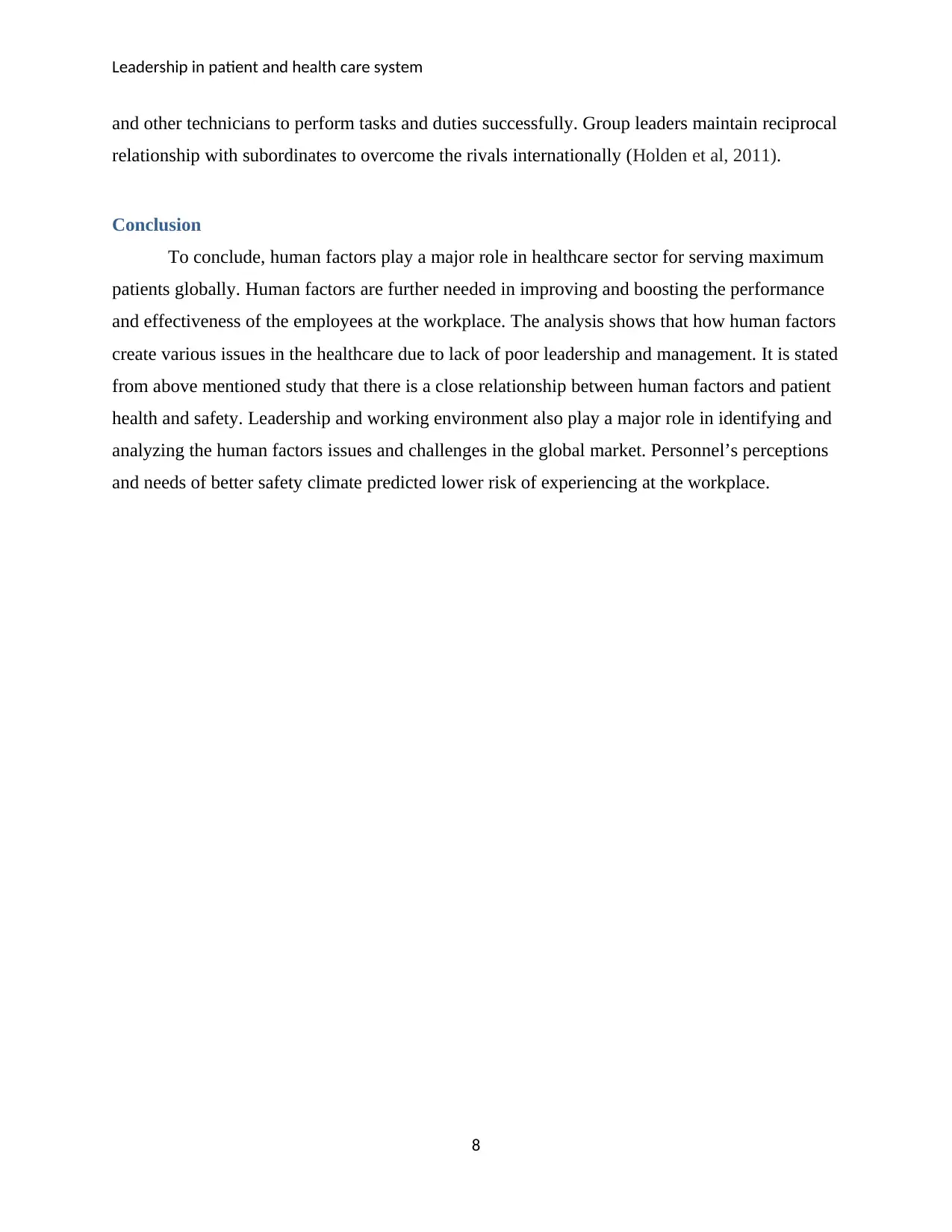
Leadership in patient and health care system
and other technicians to perform tasks and duties successfully. Group leaders maintain reciprocal
relationship with subordinates to overcome the rivals internationally (Holden et al, 2011).
Conclusion
To conclude, human factors play a major role in healthcare sector for serving maximum
patients globally. Human factors are further needed in improving and boosting the performance
and effectiveness of the employees at the workplace. The analysis shows that how human factors
create various issues in the healthcare due to lack of poor leadership and management. It is stated
from above mentioned study that there is a close relationship between human factors and patient
health and safety. Leadership and working environment also play a major role in identifying and
analyzing the human factors issues and challenges in the global market. Personnel’s perceptions
and needs of better safety climate predicted lower risk of experiencing at the workplace.
8
and other technicians to perform tasks and duties successfully. Group leaders maintain reciprocal
relationship with subordinates to overcome the rivals internationally (Holden et al, 2011).
Conclusion
To conclude, human factors play a major role in healthcare sector for serving maximum
patients globally. Human factors are further needed in improving and boosting the performance
and effectiveness of the employees at the workplace. The analysis shows that how human factors
create various issues in the healthcare due to lack of poor leadership and management. It is stated
from above mentioned study that there is a close relationship between human factors and patient
health and safety. Leadership and working environment also play a major role in identifying and
analyzing the human factors issues and challenges in the global market. Personnel’s perceptions
and needs of better safety climate predicted lower risk of experiencing at the workplace.
8
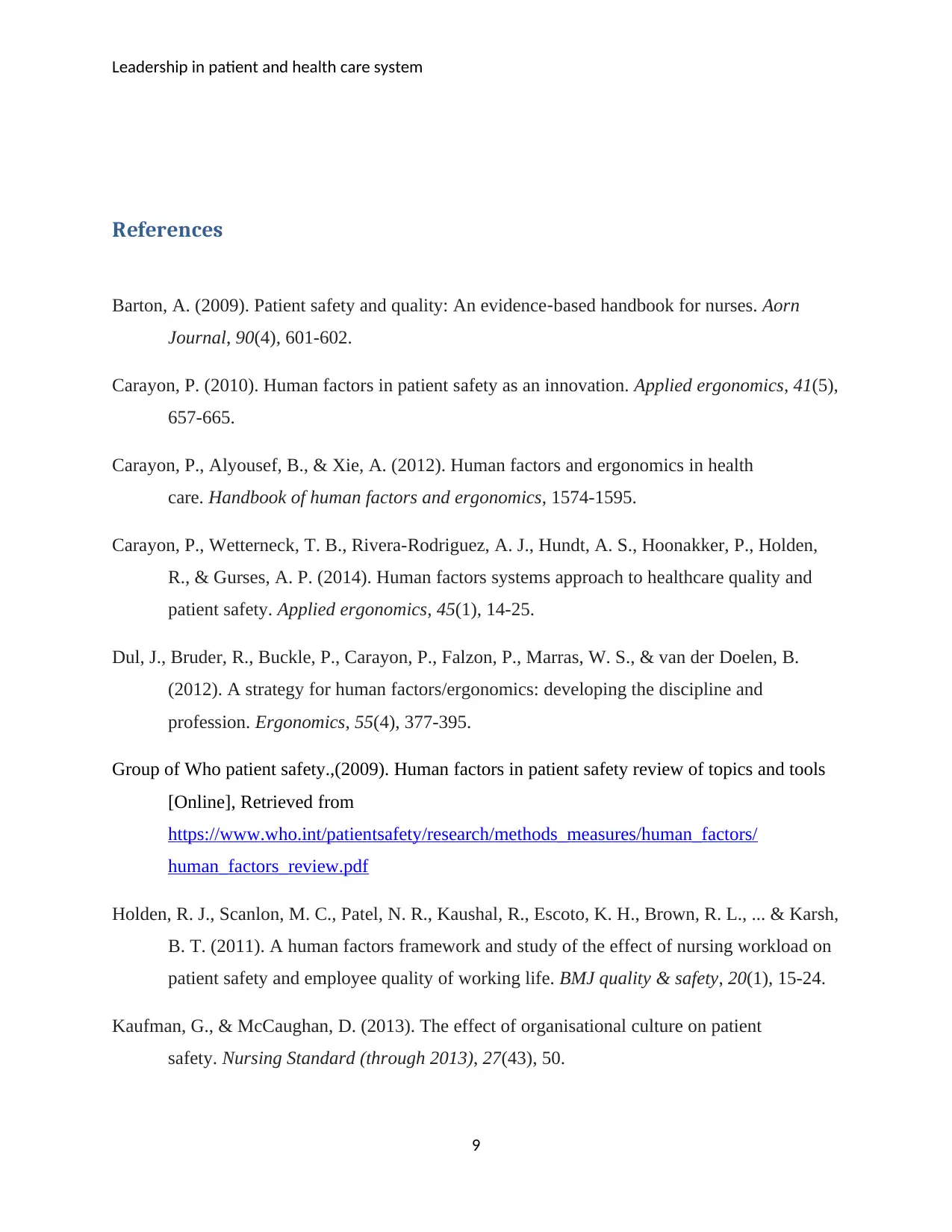
Leadership in patient and health care system
References
Barton, A. (2009). Patient safety and quality: An evidence‐based handbook for nurses. Aorn
Journal, 90(4), 601-602.
Carayon, P. (2010). Human factors in patient safety as an innovation. Applied ergonomics, 41(5),
657-665.
Carayon, P., Alyousef, B., & Xie, A. (2012). Human factors and ergonomics in health
care. Handbook of human factors and ergonomics, 1574-1595.
Carayon, P., Wetterneck, T. B., Rivera-Rodriguez, A. J., Hundt, A. S., Hoonakker, P., Holden,
R., & Gurses, A. P. (2014). Human factors systems approach to healthcare quality and
patient safety. Applied ergonomics, 45(1), 14-25.
Dul, J., Bruder, R., Buckle, P., Carayon, P., Falzon, P., Marras, W. S., & van der Doelen, B.
(2012). A strategy for human factors/ergonomics: developing the discipline and
profession. Ergonomics, 55(4), 377-395.
Group of Who patient safety.,(2009). Human factors in patient safety review of topics and tools
[Online], Retrieved from
https://www.who.int/patientsafety/research/methods_measures/human_factors/
human_factors_review.pdf
Holden, R. J., Scanlon, M. C., Patel, N. R., Kaushal, R., Escoto, K. H., Brown, R. L., ... & Karsh,
B. T. (2011). A human factors framework and study of the effect of nursing workload on
patient safety and employee quality of working life. BMJ quality & safety, 20(1), 15-24.
Kaufman, G., & McCaughan, D. (2013). The effect of organisational culture on patient
safety. Nursing Standard (through 2013), 27(43), 50.
9
References
Barton, A. (2009). Patient safety and quality: An evidence‐based handbook for nurses. Aorn
Journal, 90(4), 601-602.
Carayon, P. (2010). Human factors in patient safety as an innovation. Applied ergonomics, 41(5),
657-665.
Carayon, P., Alyousef, B., & Xie, A. (2012). Human factors and ergonomics in health
care. Handbook of human factors and ergonomics, 1574-1595.
Carayon, P., Wetterneck, T. B., Rivera-Rodriguez, A. J., Hundt, A. S., Hoonakker, P., Holden,
R., & Gurses, A. P. (2014). Human factors systems approach to healthcare quality and
patient safety. Applied ergonomics, 45(1), 14-25.
Dul, J., Bruder, R., Buckle, P., Carayon, P., Falzon, P., Marras, W. S., & van der Doelen, B.
(2012). A strategy for human factors/ergonomics: developing the discipline and
profession. Ergonomics, 55(4), 377-395.
Group of Who patient safety.,(2009). Human factors in patient safety review of topics and tools
[Online], Retrieved from
https://www.who.int/patientsafety/research/methods_measures/human_factors/
human_factors_review.pdf
Holden, R. J., Scanlon, M. C., Patel, N. R., Kaushal, R., Escoto, K. H., Brown, R. L., ... & Karsh,
B. T. (2011). A human factors framework and study of the effect of nursing workload on
patient safety and employee quality of working life. BMJ quality & safety, 20(1), 15-24.
Kaufman, G., & McCaughan, D. (2013). The effect of organisational culture on patient
safety. Nursing Standard (through 2013), 27(43), 50.
9
⊘ This is a preview!⊘
Do you want full access?
Subscribe today to unlock all pages.

Trusted by 1+ million students worldwide
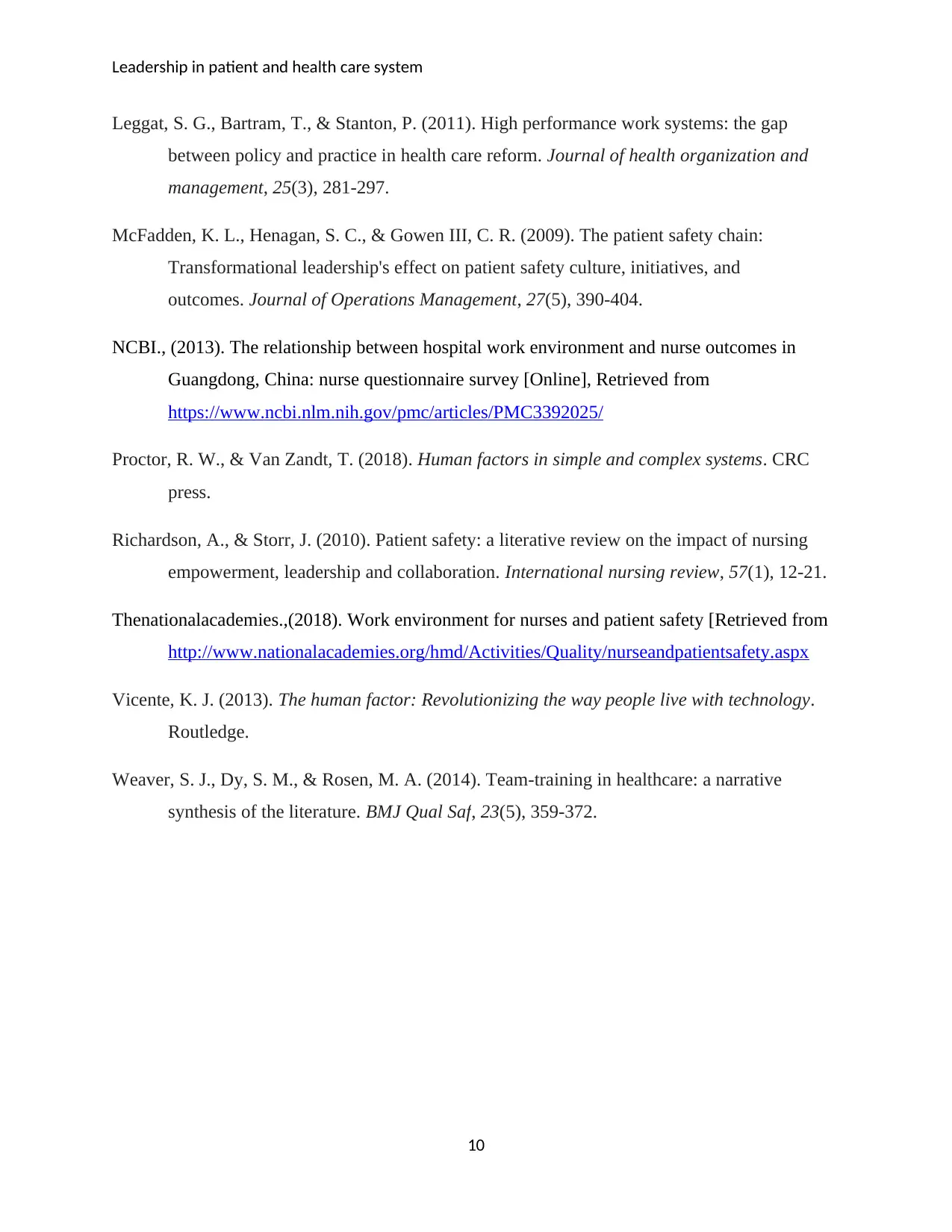
Leadership in patient and health care system
Leggat, S. G., Bartram, T., & Stanton, P. (2011). High performance work systems: the gap
between policy and practice in health care reform. Journal of health organization and
management, 25(3), 281-297.
McFadden, K. L., Henagan, S. C., & Gowen III, C. R. (2009). The patient safety chain:
Transformational leadership's effect on patient safety culture, initiatives, and
outcomes. Journal of Operations Management, 27(5), 390-404.
NCBI., (2013). The relationship between hospital work environment and nurse outcomes in
Guangdong, China: nurse questionnaire survey [Online], Retrieved from
https://www.ncbi.nlm.nih.gov/pmc/articles/PMC3392025/
Proctor, R. W., & Van Zandt, T. (2018). Human factors in simple and complex systems. CRC
press.
Richardson, A., & Storr, J. (2010). Patient safety: a literative review on the impact of nursing
empowerment, leadership and collaboration. International nursing review, 57(1), 12-21.
Thenationalacademies.,(2018). Work environment for nurses and patient safety [Retrieved from
http://www.nationalacademies.org/hmd/Activities/Quality/nurseandpatientsafety.aspx
Vicente, K. J. (2013). The human factor: Revolutionizing the way people live with technology.
Routledge.
Weaver, S. J., Dy, S. M., & Rosen, M. A. (2014). Team-training in healthcare: a narrative
synthesis of the literature. BMJ Qual Saf, 23(5), 359-372.
10
Leggat, S. G., Bartram, T., & Stanton, P. (2011). High performance work systems: the gap
between policy and practice in health care reform. Journal of health organization and
management, 25(3), 281-297.
McFadden, K. L., Henagan, S. C., & Gowen III, C. R. (2009). The patient safety chain:
Transformational leadership's effect on patient safety culture, initiatives, and
outcomes. Journal of Operations Management, 27(5), 390-404.
NCBI., (2013). The relationship between hospital work environment and nurse outcomes in
Guangdong, China: nurse questionnaire survey [Online], Retrieved from
https://www.ncbi.nlm.nih.gov/pmc/articles/PMC3392025/
Proctor, R. W., & Van Zandt, T. (2018). Human factors in simple and complex systems. CRC
press.
Richardson, A., & Storr, J. (2010). Patient safety: a literative review on the impact of nursing
empowerment, leadership and collaboration. International nursing review, 57(1), 12-21.
Thenationalacademies.,(2018). Work environment for nurses and patient safety [Retrieved from
http://www.nationalacademies.org/hmd/Activities/Quality/nurseandpatientsafety.aspx
Vicente, K. J. (2013). The human factor: Revolutionizing the way people live with technology.
Routledge.
Weaver, S. J., Dy, S. M., & Rosen, M. A. (2014). Team-training in healthcare: a narrative
synthesis of the literature. BMJ Qual Saf, 23(5), 359-372.
10
1 out of 10
Related Documents
Your All-in-One AI-Powered Toolkit for Academic Success.
+13062052269
info@desklib.com
Available 24*7 on WhatsApp / Email
![[object Object]](/_next/static/media/star-bottom.7253800d.svg)
Unlock your academic potential
Copyright © 2020–2025 A2Z Services. All Rights Reserved. Developed and managed by ZUCOL.





